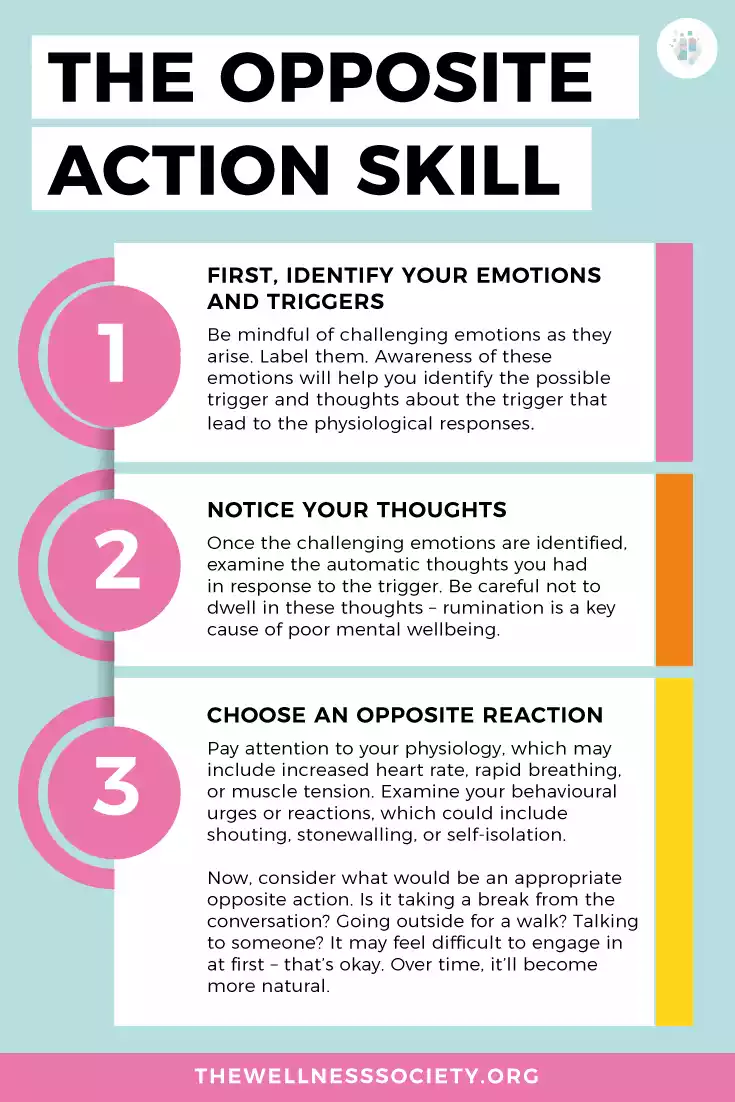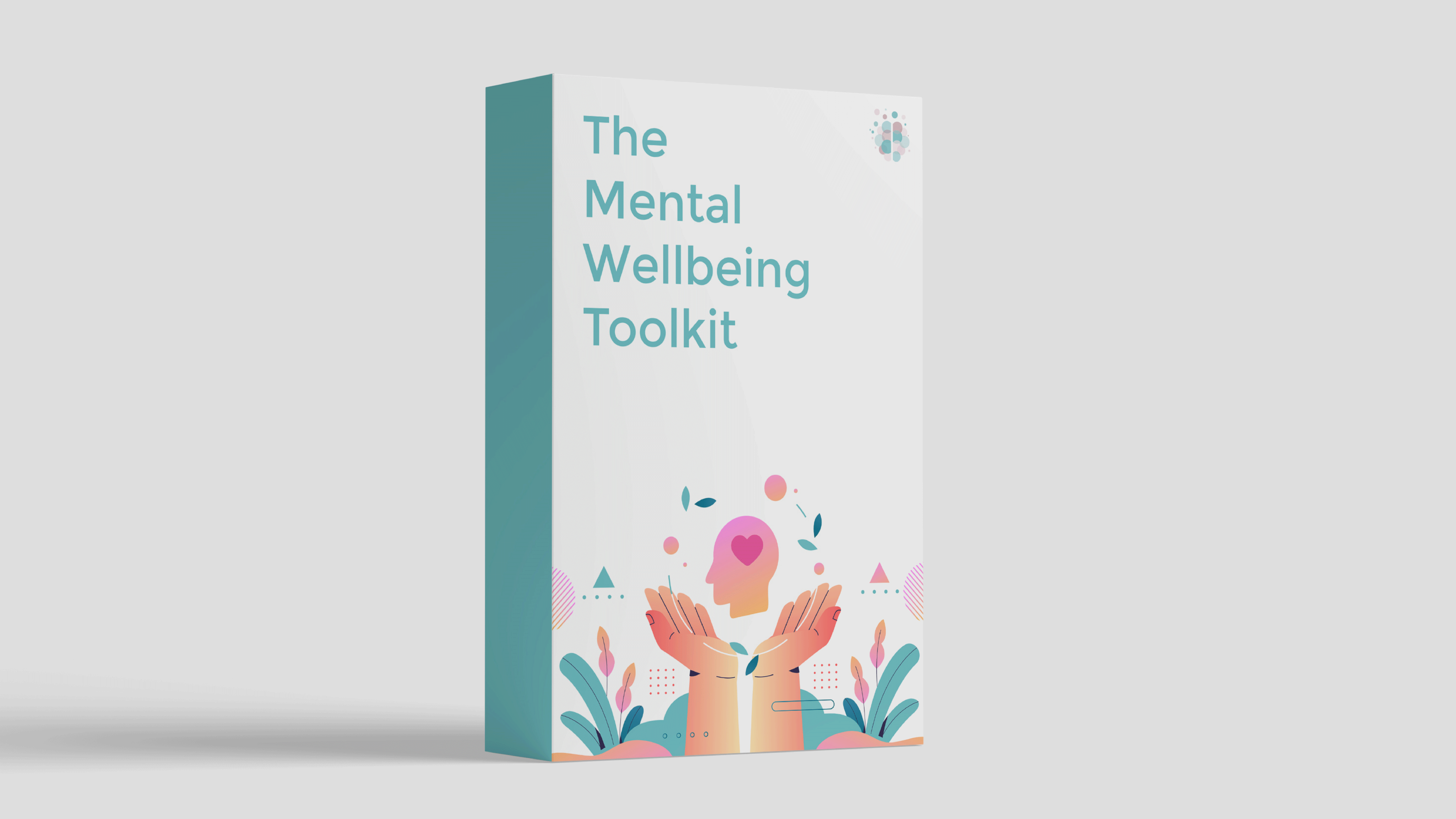Dialectical behaviour therapy (DBT) is a comprehensive and evidence-based therapeutic approach developed by acclaimed therapist Dr. Marsha Linehan. It's been found effective for a wide range of emotional regulation and interpersonal challenges.
- Mindfulness
- Emotion Regulation
- Interpersonal Effectiveness
- Distress Tolerance
The Opposite Action Technique is part of the distress tolerance module. This includes various skills aimed at helping people manage intense emotions. Other skills included in this module are:
- ACCEPTS
- STOP
- TIPP
- Pros and cons
- Radical acceptance
- Self-soothe
- IMPROVE
What Is the Opposite Action Technique?
The Opposite Action Technique essentially encourages us to act in the opposite manner than our mind and body seems to tell us to.
It’s rooted in the understanding that sometimes the most beneficial way to deal with intense emotions is to engage in actions that are opposite to the urges those emotions prompt. By deliberately choosing an opposite action, you can avoid impulsive and unhelpful behaviours, strained relationships, and reduced overall wellbeing.
For example, if you’re experiencing low mood and energy, the opposite action may involve going outside for a walk, engaging in self-care, or doing something social.
The opposite action technique teaches you to identify thoughts, triggers, and responses which in turn allows you to learn new behaviours and habits.
The Opposite Action Technique in 3 Steps
1. Identify your emotions and triggers. Be mindful of challenging emotions as they arise. Label them. Awareness of these emotions will help you identify the possible trigger and thoughts about the trigger that lead to the physiological responses.
2. Notice your thoughts. Once the challenging emotions are identified, examine the automatic thoughts you had in response to the trigger. Be careful not to dwell in these thoughts – rumination is a key cause of poor mental wellbeing.
3. Choose an opposite reaction. Pay attention to your physiology, which may include heightened heart rate, rapid breathing, or muscle tension. Examine your behavioural urges or reactions, which could include shouting, stonewalling, or self-isolation. Now, consider what would be an appropriate opposite action. Is it taking a break from the conversation? Going outside for a walk? Talking to someone? It may feel difficult to engage in at first – that’s okay. Over time, it’ll become more natural.
Example Situations for the Opposite Action Skill
- Anger management. When feeling intense anger, rather than acting aggressively, use opposite action to approach the situation calmly and assertively.
- Sadness. If you're feeling down and want to isolate yourself, use opposite action to reach out to a friend or engage in a nourishing activity.
- Anxiety. When overwhelmed with anxiety, act with courage and face your fears instead of avoiding them.
- Guilt or shame. Instead of isolating yourself or engaging in self-destructive behaviour, reach out for support, apologize, or make amends.
- Impulsivity. If you have a tendency to make impulsive decisions, pause and use opposite action to consider the consequences before acting.
- Procrastination. When you're tempted to procrastinate, use opposite action by setting a timer and starting the task for just a few minutes to build momentum.
- Self-harm urges. Instead of engaging in self-destructive behaviour, use opposite action to reach out to a therapist, a friend, or a crisis helpline.
- Substance abuse. Instead of giving in to cravings, use opposite action by engaging in a healthy activity or seeking support.
- Social anxiety. If you're avoiding social situations due to anxiety, use opposite action to attend social events or engage in small talk to desensitize yourself.
Benefits of the Opposite Action Technique
The Opposite Action Technique encourages you to pause, reflect, and choose actions that align with your long-term goals rather than giving in to impulsive emotional responses. As you consistently practice choosing actions in opposition to their initial urges, you can develop a heightened awareness of your emotions and the impact they have on your decisions.
In addition, The Opposite Action Technique can help you express more considerate and empathetic responses in your social interactions. For example, if you’re inclined to withdraw during moments of conflict due to feelings of anxiety, the technique encourages you to engage in open communication instead.
This approach not only helps prevent misunderstandings, but also fosters the development of healthier relationships built on mutual understanding and trust.
Summary
The Opposite Action Technique is more than just a strategy for managing emotions; it's a gateway to personal growth and transformation.
Its benefits extend beyond the realm of emotion regulation, touching upon various aspects of individuals' lives.
Enhanced emotional intelligence can equip you to navigate complex emotional landscapes better, while improved relationships create a nurturing support network. By promoting overall wellbeing, the technique can enable you to thrive amidst life's challenges.
Breaking habitual patterns of behaviour can be challenging, but by practising consistently, these patterns can be reshaped over time.
With The Opposite Action Technique, you can navigate life's challenges with newfound grace and resilience, ultimately embracing a life characterised by emotional harmony, fulfilling relationships, and improved mental wellbeing.
A Toolkit to Accelerate Your Mental Health Journey
Our self-guided program includes tools from DBT, CBT, ACT and more, so you can discover what works best for you. Check out The Mental Wellbeing Toolkit today – it's "like 10 therapy sessions in one."

About Matt
Matthew Schubert is a mental health counselor who owns and operates Gem State Wellness in Boise, Idaho.
He specializes in utilizing cognitive behavioral therapy (CBT) with children and adults.




